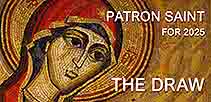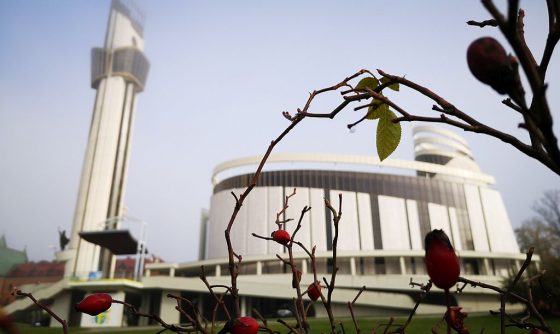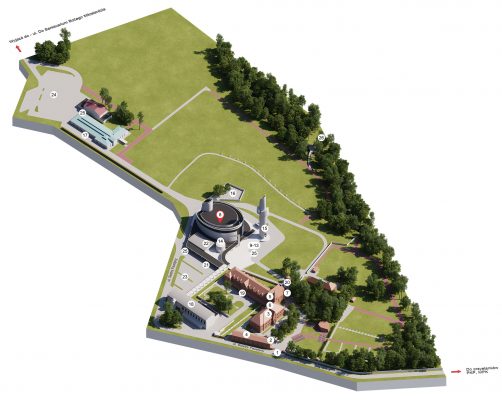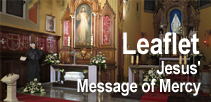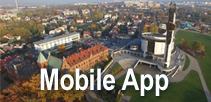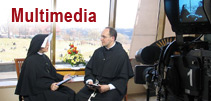We have put a map of the Shrine after the text.
We are now in front of the new, two-level Divine Mercy Basilica, which was consecrated by Pope John Paul II and where he entrusted the whole world to the Divine Mercy. The building site was consecrated in 1999 by Cardinal Franciszek Macharski, and less than three years later, on 17 August 2002, Pope John Paul II consecrated the new Basilica. In 2003 it was appointed a basilica minor, as we learn from the information board at the main entrance. Inside the porch you will see the cornerstone brought for the Basilica from Mount Calvary and plaques commemorating three pontifical pilgrimages, by Pope John Paul II (17 August 2002), Pope Benedict XVI (27 May 2006), and Pope Francis (30 July 2016).
The Basilica was designed by Witold Cęckiewicz. Its shape resembles a ship, a modern Ark of the Covenant for the salvation of all who put their trust in Divine mercy. A large stone altar stands in the chancel, and behind it there is a tabernacle in the shape of a sphere representing the world with all the continents, surrounded by a huge, wind-swept shrub symbolising the modern world and Man assailed by a variety of forces. The shrub over the tabernacle serves as a sort of framework for a picture of the Merciful Jesus (by Jan Chrząszcz) reminding that “in God’s mercy the world will find peace, and Man happiness,” as John Paul II said. The Merciful Jesus is flanked by the portraits of the Apostles of Mercy, St. Faustina and St. John Paul II (by Teresa Śliwka-Moskal).
On one side of the walls separating the chancel from the main nave there is a picture of Our Lady of Ostra Brama as Our Lady of Mercy (by Jan Chrząszcz), and on the other side there is a plaque with the full text of the Pope’s act of entrustment of the world to the Divine Mercy, with an arrangement of votive offerings displayed in glass cabinets. Two bells hang below the picture of Our Lady, one dedicated to John Paul II and presented by Michał Woźniak, a bell founder from Przemyśl, and the other, known as the Bell of Hope, consecrated in 2020 by Archbishop Marek Jędraszewski. Stained glass decorations are up in the tall windows and the one over the chancel, which has a surface area of 148 square metres and is the largest window in Kraków. It shows a huge sun with a luminous cross, the symbol of faith and the most persuasive sign of Divine mercy, superimposed on it. Below the horizon there is a vast sea, in a colour scheme harmonised with the stained glass in the side windows and intended to give the impression of emerging from the depths of the ocean. The stained glass was designed by Witold Cęckiewicz, the architect who designed the Basilica, and stained-glass artist Małgorzata Toborowicz. The musicians’ choir holds a monumental 72-voice organ made in 2017-2018 and consecrated by Archbishop Marek Jędraszewski. Below the choir you can see a group of holy water stoups with decorations symbolising baptismal rebirth and entry into God’s world. The inner surface of these vessels is turquoise, like the colour of the sea, with the shape of a fish, the symbol of the Christian people, showing through the water. Nearby there is a baptismal font with an inscription in Polish from the First Letter to the Corinthians, “For just as in Adam all die, so too in Christ shall all be brought to life” (1 Cor. 15:22). The column supporting the baptismal font is decorated with an apple and bread, symbols for sin and grace.
This was the place where, on 17 August 2002, Pope John Paul II made an act of entrustment of the entire world to the Divine Mercy. He said the following words, “Today, in this Shrine, I want to make a solemn act of entrustment of the whole world to the Divine Mercy. I do this in the ardent aspiration that the message of God’s merciful loved which was announced here through the services of Sister Faustina may reach all the inhabitants of the world and fill their hearts with hope.” Two years earlier, on the day he canonised Sister Faustina in 2000, he passed this message on to the entire Church for the third millennium, to give people a fuller knowledge of the true face of God and Man. He said that the time had come “for the message of Divine mercy to fill human hearts with hope and enkindle a new civilisation ‒ the civilisation of love.”
Every year celebrations are held in this Basilica and during the outdoor Masses and services held in the convent grounds for the Feast of Divine Mercy. Tens of thousands of pilgrims come from scores of countries all around the world to attend them. The ceremonies started spontaneously in 1944 and have been continued ever since. In 1985, Cardinal Franciszek Macharski, Metropolitan Archbishop of Kraków, officially instituted this feast in his diocese, and he was the first ordinary to do so. Ten years later, the Holy See issued its consent to the celebration of this feast day in all the dioceses of Poland. Finally, on the day when Sister Faustina was canonised, Pope John Paul II entered the Feast of the Divine Mercy into the liturgical calendar for the entire Church, thereby fulfilling the request Jesus made when He said to Sister Faustina that He wanted the Feast of the Divine Mercy celebrated on the first Sunday after Easter.
Jesus appeared to Sister Faustina several times to explain why He wanted this Feast instituted, its place in the liturgical calendar, how to prepare for it, how to celebrate it, and all the promises He attached to it. The preparation for the Feast is a novena consisting of the Chaplet said for nine days before the Feast. Jesus said that in this novena He would grant souls all the graces they asked for (Diary 796). Jesus attached the biggest promise to this Feast, or more precisely, He promised people who received Holy Communion on the day of the Feast the grace of remission of all their sins and the punishment for them, which is one of the graces bestowed at Baptism. The condition to receive this grace is that you have to make a good Confession, which you can do in advance, because you have to be free from all sin, even venial sins, and must trust in God, that is want to do His will, and practise an active love of your neighbour. “On that day are open all the Divine floodgates through which graces flow;” Jesus said, “let no soul fear to approach Me, even if its sins be as scarlet” (Diary 699).
Every year the words of Jesus prove true, as our pilgrims tell us. Here is one of their stories. One year, a young man from Slovakia came to Łagiewniki with a group of friends for the Feast of Mercy. He had been through a lot of additions ‒ drug parties, women, alcohol; he had dropped out of school, abandoned his family, and finally took up magic, which was supposed to liberate him but in reality only made him sink even deeper. His narcotic trances got so strong that he simply lost control of them. He was persecuted by bouts of fear, hopelessness, and paranoia and felt that it was all falling on top of him. Then he discovered Jesus among all the various other deities, but Jesus was different from them all, because He is Love. He came to Łagiewniki for the Feast of the Divine Mercy to see the place he had heard of. He was amazed to see crowds of people on their knees, addressing their requests to God. He decided to go to Confession, after so many years. He went down on his knees and begged God to forgive him for all the evil he had done. Then he received Holy Communion and was so happy that he wept. On that day God cured him of all his addictions and his life changed completely.
Every day priests dispense a pastoral service not only before the Basilica’s altar but also in the Sacrament of Reconciliation (from 8 a.m. to 7 p.m. on weekdays, and from 9 a.m. to 7 p.m. on Sundays). Jesus told Sister Faustina that it is in Confession, the Sacrament of Penance, that the greatest miracles are worked: “To obtain such a miracle, you don’t have to go on a pilgrimage to a faraway place, neither do you have to perform any outward ceremonies, all you have to do is come to one of My representatives in a spirit of faith and tell him of your misery, and the miracle of Divine mercy will come about in all its fullness. Even should a soul be like a rotting carcass and even if to human eyes there should be no restoration and everything seemed to be utterly lost – for God it’s not like that, the miracle of Divine mercy raises up that soul completely. O, poor ones who do not make use of that miracle of Divine mercy – you shall cry out in vain, but it will be too late” (Diary 1148).
If you visit the Basilica on any of the days listed below, you can obtain a plenary indulgence on the ordinary conditions by saying the Lord’s Prayer and the Creed, on
- The anniversary of the consecration of the Basilica (17 August).
- The day on which its titular feast (Divine Mercy Sunday) is celebrated.
- The feast of the Apostles St. Peter and St. Paul (29 June).
- The anniversary of the day on which this church was raised up to the rank of a basilica minor (6 March).
- Once a year, on a day appointed by the local ordinary (on the feast day of St. Faustina, 5 October).
- Once a year, on the day of the worshipper’s personal choice.
An on-line transmission from the Basilica is available on the website of the Shrine’s Rectory, www.misericordia.eu
- Main entrance to the Shrine
- Sister Faustina’s House: hotel & museum
- Convent
- Antoninek House: Faustinum Association
-
Merciful Jesus Chapel & Saint Faustina’s Tomb: Heart of the Shrine
- Oratory: room where Saint Faustina died
- Chapel of the Lord’s Passion
- Divine Mercy Basilica
- Saint Faustina’s Chapel
- The Communio Sanctorum Chapel
- Saint Andrew’s Chapel
- The Holy Cross Chapel
- The Chapel of Our Lady of the Seven Sorrows
- Perpetual Adoration Chapel
- Viewing Tower
- Convent Graveyard
- Sister Faustina’s House: restaurant, souvenirs & meeting hall
- Pastoral Lodge: hotel & restaurant
- Mercy House
- Information Booth
- Souvenirs & Misericordia Bookshop
- Saint John Paul II Hall
- Car park
- Car and coach park
- Toilets
- Bridge of Mercy, for the Saint John Paul II Shrine & tram stop










